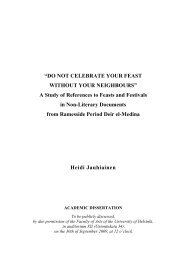BIA
bia51
bia51
You also want an ePaper? Increase the reach of your titles
YUMPU automatically turns print PDFs into web optimized ePapers that Google loves.
JUIN 2015<br />
‘Abd al-‘Azîz said the dome was restored in<br />
1905 by the Comité des Antiquités, an early<br />
heritage organisation. The mausoleum is a<br />
large domed cube typical of late Burgi<br />
Mameluke buildings, set within an enclosure<br />
entered through the gate opposite a drinking<br />
trough built by the Mameluke Aymitsh.<br />
All that remains of a much larger complex,<br />
the structure is a magnificent example of late<br />
Mameluke workmanship, including double-leaf<br />
cresting, windows in the form of three oculi<br />
over three arched panels, roundel inscriptions<br />
with the amir’s name, double bands of<br />
moulding and decorated shoulder cascades in<br />
the dome’s transition zone.<br />
‘Abd al-‘Azîz said the restoration of the<br />
dome included the removal of several metres<br />
of rubbish that had accumulated around the<br />
monument, structural consolidation and<br />
conservation of both the interior and exterior<br />
surfaces of the mausoleum, madrasa and sabîlkuttâb.<br />
The exterior spaces have been<br />
reorganised in order to prepare the area as<br />
the southern entry point to al-Azhar Park. The<br />
restoration work started in 2006.<br />
MONREAL said that both the Ayyubid walls<br />
and the Tarâbây al-Sharîfî monuments are part<br />
of the broader urban regeneration projects<br />
begun in 1984 when the Aga Khan Award for<br />
Architecture sponsored a symposium in Cairo<br />
titled “The Expanding Metropolis: Coping with<br />
the Urban Growth of Cairo.”<br />
At that time, the AKTC offered to create a<br />
park for the citizens of the capital. The<br />
creation of al-Azhar Park and the numerous<br />
urban regeneration projects around it, including<br />
the Ayyubid walls and the restoration of the<br />
Tarâbây Complex, speaks to the possibility of<br />
rejuvenating areas that once appeared to be in<br />
terminal decline, he said. Another example is<br />
the restoration of the 14 th -century Amir<br />
Aqsunqur “Blue Mosque” in al-Darb al-Ahmar,<br />
which was inaugurated a month ago.<br />
In all of its restoration and regeneration<br />
work, MONREAL said, the AKTC has the objective<br />
of leveraging culture in ways that could lead to<br />
the alleviation of poverty.<br />
In al-Darb al-Ahmar, one of the poorest<br />
districts in Cairo, the Trust has consciously<br />
worked to create a critical mass of activities<br />
that not only focus on the restoration of<br />
monuments, but also on the creation of public<br />
spaces, water and sanitation improvements,<br />
education and health initiatives, microfinance<br />
and employment generation and training, he<br />
said.<br />
The 1984 programme not only aimed to<br />
create a park visited by almost two million<br />
people a year, MONREAL said, but also extended<br />
to socioeconomic initiatives in the neighbouring<br />
al-Darb al-Ahmar district, including housing<br />
rehabilitation, microfinance, apprenticeships and<br />
healthcare.<br />
Local housing was renovated and returned<br />
to its owners. Job training and employment<br />
opportunities were offered in different sectors<br />
such as shoemaking, furniture manufacturing<br />
and tourist goods production. Apprenticeships<br />
were made available in automobiles, electronics,<br />
mobile telephones, computers, masonry,<br />
carpentry and office skills.<br />
Microcredit loans enabled residents to open<br />
small businesses such as carpentry shops and<br />
a drycleaner. Hundreds of young men and<br />
women in the al-Darb al-Ahmar area have<br />
found work in the park, in horticulture and on<br />
project teams restoring the Ayyubid walls,<br />
MONREAL said. (Nevine El-Aref, “Historic Ayyubid<br />
walls reopen”, Al-Ahram Weekly, June 25, 2015.<br />
Voir également MENA, « Le ministre de<br />
l’Archéologie : La restauration de la muraille<br />
Est et de la coupole de Tarâbây a coûté 9,1<br />
millions de dollars », al-Shurûq, 16 juin ;<br />
“Minister: Cairo eastern wall renovated for $8.5<br />
million”, Egypt Independent, June 17 ; Dînâ<br />
‘Abd al-‘Alîm, « Le ministre de l’Archéologie :<br />
L’inauguration de la muraille du Caire contribue<br />
à l’essor du tourisme », al-Yawm al-Sâbi‘, 17<br />
juin).<br />
- -<br />
Dimanche 28 juin 2015<br />
Sultân ‘Îd, head of Luxor Antiquities, has<br />
denied media reports that artefacts have been<br />
stolen from Karnak temple galleries. He told<br />
Ahram Online that all the artefacts are safe<br />
and sound. The car which was parked at the<br />
western gate of Karnak temple, he continued,<br />
belonged to the archaeological mission of the<br />
<strong>BIA</strong> LI — Janvier/Juin 2015 161



